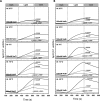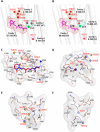Non-cryogenic structure of a chloride pump provides crucial clues to temperature-dependent channel transport efficiency
- PMID: 30455349
- PMCID: PMC6341376
- DOI: 10.1074/jbc.RA118.004038
Non-cryogenic structure of a chloride pump provides crucial clues to temperature-dependent channel transport efficiency
Abstract
Non-cryogenic protein structures determined at ambient temperature may disclose significant information about protein activity. Chloride-pumping rhodopsin (ClR) exhibits a trend to hyperactivity induced by a change in the photoreaction rate because of a gradual decrease in temperature. Here, to track the structural changes that explain the differences in CIR activity resulting from these temperature changes, we used serial femtosecond crystallography (SFX) with an X-ray free electron laser (XFEL) to determine the non-cryogenic structure of ClR at a resolution of 1.85 Å, and compared this structure with a cryogenic ClR structure obtained with synchrotron X-ray crystallography. The XFEL-derived ClR structure revealed that the all-trans retinal (ATR) region and positions of two coordinated chloride ions slightly differed from those of the synchrotron-derived structure. Moreover, the XFEL structure enabled identification of one additional water molecule forming a hydrogen bond network with a chloride ion. Analysis of the channel cavity and a difference distance matrix plot (DDMP) clearly revealed additional structural differences. B-factor information obtained from the non-cryogenic structure supported a motility change on the residual main and side chains as well as of chloride and water molecules because of temperature effects. Our results indicate that non-cryogenic structures and time-resolved XFEL experiments could contribute to a better understanding of the chloride-pumping mechanism of ClR and other ion pumps.
Keywords: X-ray crystallography; X-ray free electron laser; anion pump; chloride transport; circular dichroism (CD); light-driven chloride pump; non-cryogenic condition; rhodopsin; serial femtosecond crystallography; structure-function; temperature dependence; time-resolved XFEL; transport efficiency; ultraviolet-visible spectroscopy (UV-Vis spectroscopy).
Conflict of interest statement
The authors declare that they have no conflicts of interest with the contents of this article
Figures





References
-
- Chae P. S., Rasmussen S. G., Rana R. R., Gotfryd K., Chandra R., Goren M. A., Kruse A. C., Nurva S., Loland C. J., Pierre Y., Drew D., Popot J. L., Picot D., Fox B. G., Guan L., et al. (2010) Maltose-neopentyl glycol (MNG) amphiphiles for solubilization, stabilization and crystallization of membrane proteins. Nat. Methods 7, 1003–1008 10.1074/jbc.RA117.001068 - DOI - PMC - PubMed
-
- Chun E., Thompson A. A., Liu W., Roth C. B., Griffith M. T., Katritch V., Kunken J., Xu F., Cherezov V., Hanson M. A., and Stevens R. C. (2012) Fusion partner toolchest for the stabilization and crystallization of G protein-coupled receptors. Structure 20, 967–976 10.1074/jbc.RA117.001068 - DOI - PMC - PubMed
Publication types
MeSH terms
Substances
Associated data
- Actions
- Actions
- Actions
Grants and funding
LinkOut - more resources
Full Text Sources
Miscellaneous

